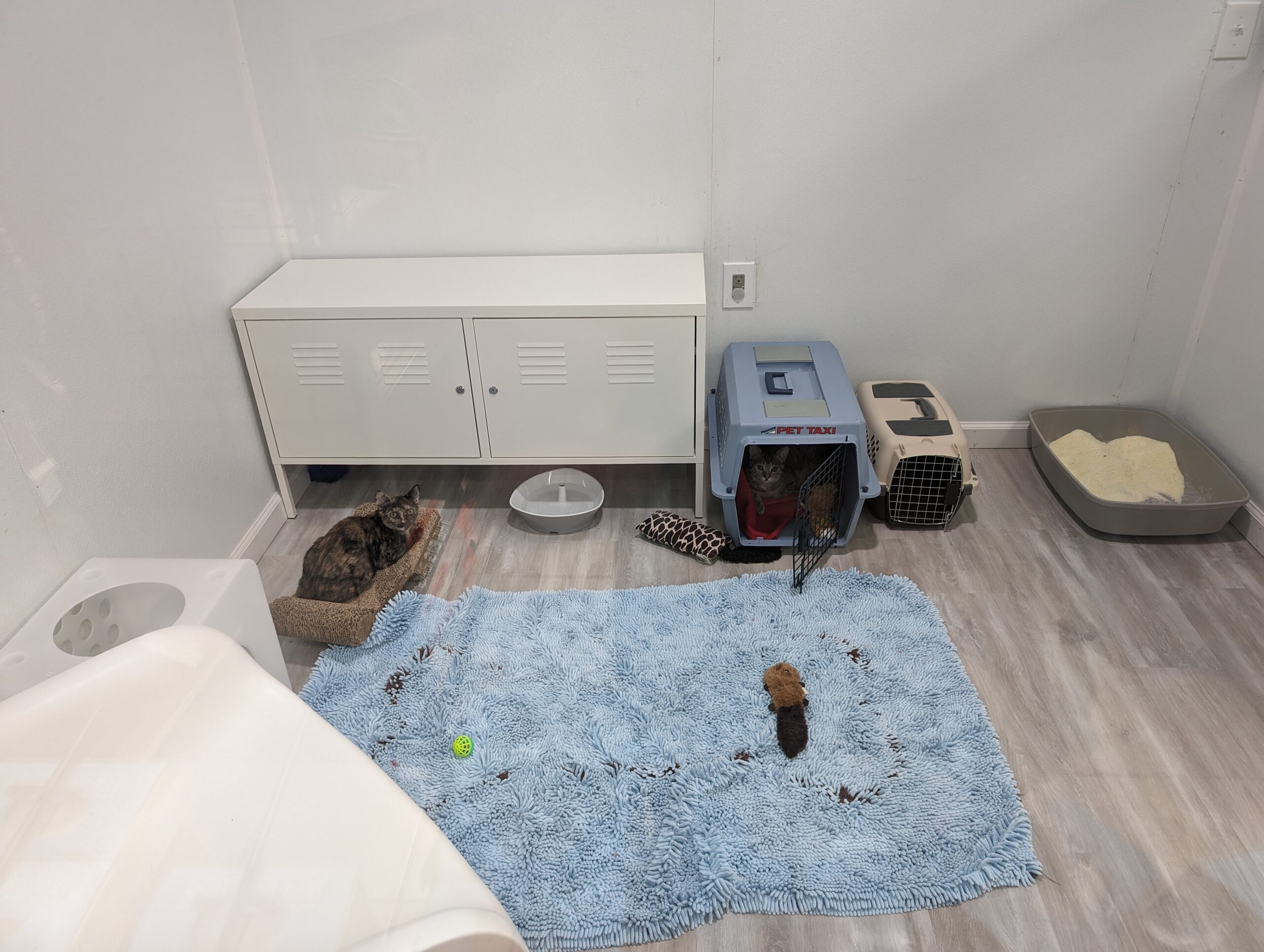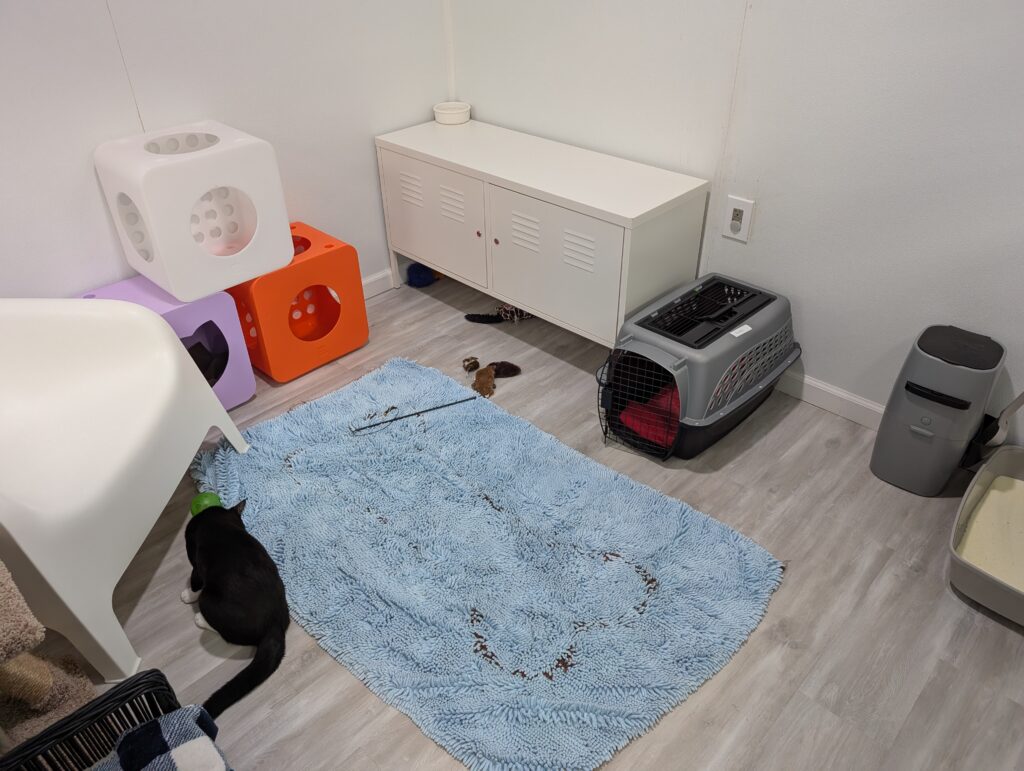
Setting Up Base Camp
Congratulations on the decision to add a feline friend to your family! You should expect that your cat will need an adjustment period when coming home and setting up a base camp is a great way to help them in the transition.
Base camp is a name for a room that can be dedicated to your new cat for a couple weeks while they settle into life with you. This is going to become the most important room in your cat’s territory and will likely be the room that your cat will enjoy spending time in most, even after they are released to roam the house. It is also likely where they will feel safest and will retreat to in an emergency or when they are stressed. A good choice is your bedroom, but any room will work. The key is that the cat will only be in this room for about two weeks. This gives them time to adjust to new sounds and smells without becoming overwhelmed. If there are other pets in the home, having them separated in this manner is a good starting point for introductions and gets everyone started off on the right foot.

You’ll want enough space for a litter box, a soft place to sleep, something appropriate to scratch on, and food and water bowls. Make sure that the food and water bowls are away from the litter box as much as possible when you are setting up! Its also a good idea to keep the food and water bowls somewhat separated if you have the space. Cats often prefer not to drink right by their food because in the wild, that means that the water supply was likely contaminated by their kill.
Some considerations when choosing items for base camp
Here we will go through some of the critical items you’ll want to include in your cat’s base camp set-up. For more in-depth information and explanation, we encourage you to check out the books Catification and Catify to Satisfy, by Jackson Galaxy and Kate Benjamin.
Food/Water Bowls
When choosing a food or water bowl it is a good idea to go with stainless steel, glass, or ceramic. Plastic bowls scratch easily and can harbor bacteria in those scratches with long-term use. When considering a water bowl, it is worth looking into a fountain instead or a standard bowl. Many cats prefer running water and a fountain can encourage cats with a low thirst drive to drink more. This can help stave off several health issues later in life, most notably, kidney disease.
Scratching Surfaces
Providing appropriate scratching surfaces for your cat is important to their mental well being as well as keeping your furniture free from inappropriate scratching. Scratching posts or mats allow your cat to spread their scent and have a sense of ownership of the space. Cats have different preferences when it comes to scratching surfaces so providing a variety from the start is a great idea. You can make a simple scratch post with a 2×4 and some sisal rope from your local hardware store. This can then either be laid on the floor or mounted to the wall, depending on your cat’s preference. It is important to consider that in a vertical scratching post, the cat should be able to stand up and stretch to their full length without hitting the end of the post. Carpet squares also make great scratching surfaces and can be mounted directly on the wall, on a shelf, or on a piece of wood to sit on the floor.
Litter Box/Litter
When choosing a litter box and litter for your cat, there are several things to keep in mind.
● Covered litter boxes often do nothing to help the smell of a cat box. (A good litter is the best help for those with smell concerns.) Covered boxes are akin to a porta-potty in that they are stuffy and harbor unpleasant smells for your cat. In multi-cat households, a covered litter box also provides a perfect spot for bullying and ambushing because it cuts off the field of vision for the cat inside. In these situations, the bullied cat can actually develop an aversion to using the litter box. Covered boxes may cut down on litter scatter but there are several other options available that do not have so many potential downsides.
● The litter box should be large enough for your cat to turn around in completely and comfortably. The bigger the better.
● High-sided boxes are the best for cutting down on scatter and kicked up litter but can be difficult to enter for older cats.
● Scented litter can be off-putting for cats. Their sense of smell is much stronger than ours so that “light” scent can be overwhelming to cats who must stand and dig in the litter with their nose just inches away.
● Young kittens (four months and under) should not be allowed to use clumping litter. They are very curious and tend to explore with their mouths. It is not abnormal for kittens to eat litter, accidentally or on purpose, so you don’t want something that can clump and cause an intestinal blockage.
● Automatic or self-scooping litter boxes should be avoided in our opinion. These can give an unsuspecting cat quite the scare and can cause litter box avoidance. Scooping the box also gives you the chance to observe your cat’s bathroom habits and become familiar with what is normal for them, valuable information when determining if your cat may be falling ill.
Extras
Toys, beds, towers, and other fun things should definitely be included in your base camp room. A variety of toys will help you get a feel for which ones your cat prefers, and don’t forget some interactive toys like wand toys or laser pointers! (A quick note about laser pointers: We love laser pointers and we know that our feline friends do too! However, if that is the only way you ever play with your cat, it can eventually become a problem for them. Obsessing over something that they never catch is not good for a cat’s mental health and can cause obsessive or neurotic behaviors. To avoid this, make sure to end each of your laser pointer sessions with a real, tangible toy. You want your cat to be able to have the satisfaction of “catching” something after all that hunting (aka play time) and really be able to sink their teeth and claws into it.)
If you find that your cat is spending a lot of time under the bed or in the closet hiding away, it can be beneficial to provide them with an alternative and then block off those areas. Providing a covered bed, a cozy carrier with a blanket inside and overtop, a cat cave, or simply a box on its side gives the cat a hiding place that can be moved around and help them feel secure even in open spaces. This is a much more useful place to hide than under the bed, which never allows your cat the chance to experience their whole home and get used to the sights, sounds, and smells up close.
If you have any questions about this process, about your new cat, or about anything generally cat related, please don’t hesitate to contact us! We are happy to help you and your new pet in any way that we can! Reach us at contact@velvetacres.org
Recommended reading for further information:
Catification, Jackson Galaxy and Kate Benjamin
Catify to Satisfy, Jackson Galaxy and Kate Benjamin
Jackson Galaxy’s website
Kate Benjamin’s website
